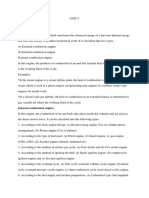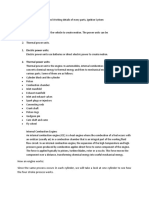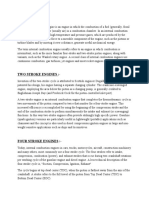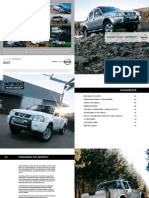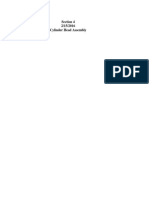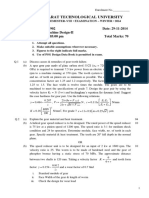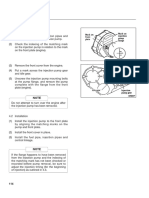Assignment 1
Uploaded by
Ikhwan TeeAssignment 1
Uploaded by
Ikhwan Tee1. A.
Intake valve, rocker arm and spring: - The valve in head engine has pushrods that extend upward from the camp followers to rocker arms mounted on the cylinder head that contact the valve stems and transmit the motion produced by the cam profile to the valves. Clearance (usually termed tappet clearance) must be maintained between the ends of the valve stems and the lifter mechanism to assure proper closing of the valves when the engine temperature changes. This is done by providing pushrod length adjustment or by the use of hydraulic lifters. Noisy and erratic valve operation can be eliminated with entirely mechanical valve lifter linkage only if the tappet clearance between the rocker arms and the valve stems is closely maintained at the specified value for the engine as measured with a thickness gauge. Hydraulic valve lifters, now commonly used on automobile engines, eliminate the need for periodic adjustment of clearance. B. Valve cover: - Valve cover breathers are located on top of the valve covers, in the oil-filling hole. The valve cover comes in different sizes. First function is to allow the release of internal pressure in the engine to be vented to the intake manifold. The second function is to have a design to prohibit any debris from entering the engine through the breather and to prevent oil in the valve cover from being sucked out of the valve cover by the suction of the intake manifold. C. Intake port: - An intake port for an internal-combustion engine is composed of an inlet duct which is constructed in the cylinder head and has a more curved section close to the combustion space and a flat or less curved section away from the combustion space. D. Head: - The cylinder head is the metal part of the engine that encloses and covers the cylinders. Bolted on to the top of the block, the cylinder head contains combustion chambers, water jackets and valves (in overheadvalve engines). The head gasket seals the passages within the head-block connection, and seals the cylinders as well. E. Coolant: - Engine coolant is used as a means of convective heat transfer. Engine coolant removes heat generated from the engine block and head by movement of the fluid in the coolant via passages or channels in the engine system. Theres another function of coolant which is to prevent corrosion.
F. Engine Block: -
G. Oil pan: - At the bottom of the crankcase is the container containing the lifeblood of the engine. Usually constructed of thin steel, it collects the oil as it flows down from the sides of the crankcase. The pan is shaped into a deeper section, where the oil pump is located. At the bottom of the pan is the drain plug, which is used to drain the oil. The plug is often made with a magnet in it, which collects metal fragments from the oil. H. Oil sump: -
I. Camshaft: - The part of a machine used to provide a repetitive straight-line or back-and-forth motion to a second part, known as the follower. Cams are used to open and close the inlet and exhaust valves of a motor car engine, to index parts of automatic machinery for mass production, and to operate a sequence of control switches in electrical equipment and many other machines. Complex cam shapes may be required to produce a desired motion.
J. Exhaust valve, rocker arm and spring: K. Spark plug: - A spark plug is a device, inserted into the combustion chamber of an engine, containing a side electrode and insulated center electrode spaced to provide a gap for firing an electrical spark to ignite air-fuel mixtures.
L. Exhaust port: -
M. Piston: - The piston converts the potential energy of the fuel, into the kinetic energy that turns the crankshaft. The piston is a cylindrical shaped hollow part that moves up and down inside the engine's cylinder. It has grooves around its perimeter near the top where rings are placed. The piston fits snugly in the cylinder. The piston rings are used to ensure a snug "air tight" fit.
N. Connecting rod: - The connecting rod links the piston to the crankshaft. The upper end has a hole in it for the piston wrist pin and the lower end (big end) attaches to the crankshaft. Connecting rods are usually made of alloy steel, although some are made of aluminum.
O. Rod bearing: - Connecting rod bearings are inserts that fit into the connecting rod's lower end and ride on the journals of the crankshaft.
P. Crankshaft: - The crankshaft converts the up and down (reciprocating) motion of the pistons into a turning (rotary) motion. It provides the turning motion for the wheels. It works much like the pedals of a bicycle, converting up-down motion into rotational motion. The crankshaft is usually either alloy steel or cast iron.
2.
Explanation: Induction The engine cycle begins with the intake stroke as the piston is pulled towards the crankshaft (second figure).
Compression: With both valves closed, the combination of the cylinder and combustion chamber form a completely closed vessel containing the fuel/air mixture. As the piston is pushed to the right, the volume is reduced and the fuel/air mixture is compressed during the compression stroke, (3rd figure).
Power: At the beginning of the power stroke, the electrical contact is opened. The sudden opening of the contact produces a spark in the combustion chamber which ignites the fuel/air mixture. Rapid combustion of the fuel releases heat, and produces exhaust gases in the combustion chamber. (5thth figure).
Exhaust: At the end of the power stroke, the piston is located at the far left. Heat that is left over from the power stroke is now transferred to the water in the water jacket until the pressure approaches atmospheric pressure. The exhaust valve is then opened by the cam pushing on the rocker arm to begin the exhaust stroke. (6th diagram).
3.
4. OVERHEAD VALVES Valves are used for two major purposes i.e. suction of fuel and for the discharge of exhaust gases. In an overhead valve (OHV) engine, the valves are mounted in the cylinder head, above the combustion chamber. Usually this type of engine has the camshaft mounted in the cylinder block, and the valves are opened and closed by push rods. Some other valves are, OVERHEAD CAMSHAFT (OHC) Some engines have the camshaft mounted above, or over, the cylinder head instead of inside the block (OHC "overhead camshaft" engines). This arrangement has the advantage of eliminating the added weight of the rocker arms and push rods; this weight can sometimes make the valves "float" when you are moving at high speeds. The rocker arm setup is operated by the camshaft lobe rubbing directly on the rocker. Stem to rocker clearance is maintained with a hydraulic valve lash adjuster for "zero" clearance. The overhead camshaft is also something that we think of as a relatively new development, but it's not. In 1898 the Wilkinson Motor Car Company introduced the same feature on a car. Advantage of twin overhead cam: Its advantage to having a twin overhead cam engine is that the engine has twice as many intake and exhaust valves as a single overhead motor. This makes the engine run cooler and more smoothly, quietly, and efficiently.
Disadvantage: Cost more for repairs.
5. a) Fan scavenged, -
b) Crank-case scavenged, -
c) -
d) -
6. -
7. - The basic principle that drives the starter motor, which is a DC motor, is Faradays Law which states that electrical current is produced when there is relative motion between a conductor and magnetic field. Of course the law is stated for a generator, however the opposite is also true, motion is produced when a current carrying wire is in the presence of magnetic field. The motion is determined by two factors, the direction of the current and the direction of the magnetic field. The starter motor converts electrical energy to mechanical energy and is mounted on the cylinder block in a position to engage a ring gear on the engine flywheel. Starting is usually accomplished by the operator activating a starter switch as part of ignition key operation. This allows a relatively small current to flow to a starter solenoid relay and operate a plunger attached to a drive pinion engagement lever. Plunger movement engages the drive pinion with the ring gear and closes a set of heavy duty contacts, allowing a large current to flow from the battery to the starter motor, rotating the armature and drive pinion, and causing the crankshaft to spin. When the engine starts and is able to run on its own, the operator usually releases the key and this withdraws the pinion from the ring gear and brings the armature to a halt.
8. Charging System The function of the automobile battery is to supply a sufficient amount of electricity to the automobile's electrical components such as the starter motor, headlights and wipers. However, the battery is limited in its capacity and is not capable of providing, on a continuing basis, All the power required by the automobile.
9. Cooling system: i) ii) Air cooling system. Water cooling system.
Components for water cooling system are: i) ii) iii) iv) v) vi) Water jacket Circulation of coolant Radiator Cooling fan Thermostat Temperature indicator
Lubricating system: i) ii) Splash type Force-feed type
10. - Economic impact of the development and use
of internal combustion engine is
You might also like
- EX.5 - Assembly and Disassembly of Ic Engine Parts75% (12)EX.5 - Assembly and Disassembly of Ic Engine Parts6 pages
- DOOSAN DE12T DE12TI DE12TIA DE2TIS 11L M. Taller 2005 PDF100% (3)DOOSAN DE12T DE12TI DE12TIA DE2TIS 11L M. Taller 2005 PDF188 pages
- Fuel Is Any Material That Can Be Made ToNo ratings yetFuel Is Any Material That Can Be Made To13 pages
- Aim: To Study The Constructional Detail of I.C.EngineNo ratings yetAim: To Study The Constructional Detail of I.C.Engine12 pages
- Unit 7 Typical Marine Diesel Engines 3.1. DoxfordNo ratings yetUnit 7 Typical Marine Diesel Engines 3.1. Doxford7 pages
- Scms College of Polytechnics, Vaikkara Shim Underbucket TechnologyNo ratings yetScms College of Polytechnics, Vaikkara Shim Underbucket Technology29 pages
- English Task 6: Machine and Motors: Author: Nazhmi FadhilaNo ratings yetEnglish Task 6: Machine and Motors: Author: Nazhmi Fadhila4 pages
- What Are The Main Parts of An Automobile Engine?: 1. Cylinder BlockNo ratings yetWhat Are The Main Parts of An Automobile Engine?: 1. Cylinder Block13 pages
- Side Valve and Over Head Valve Operating MechanismsNo ratings yetSide Valve and Over Head Valve Operating Mechanisms7 pages
- Lecture - 2: I. C. Engines Working Principles of I.C. Engines Study of Different Components of I.C. EnginesNo ratings yetLecture - 2: I. C. Engines Working Principles of I.C. Engines Study of Different Components of I.C. Engines29 pages
- Reciprocating Engine Parts Design: G.T.U. B.E. (Mech) Sem-Viii 2011-12No ratings yetReciprocating Engine Parts Design: G.T.U. B.E. (Mech) Sem-Viii 2011-1261 pages
- Automative Electronics and Hybrid VehicleNo ratings yetAutomative Electronics and Hybrid Vehicle34 pages
- Internal Combustion Engines 2025-2024 كتابNo ratings yetInternal Combustion Engines 2025-2024 كتاب229 pages
- GMOD Engine Build Manual Sections 4-11 02152016No ratings yetGMOD Engine Build Manual Sections 4-11 0215201651 pages
- Item Standard Value Limit Value Valve Sinkage - 0.1 To 0.1 MM (-0.004 To 0.004 In.) 0.5 MM (0.020 In.)No ratings yetItem Standard Value Limit Value Valve Sinkage - 0.1 To 0.1 MM (-0.004 To 0.004 In.) 0.5 MM (0.020 In.)11 pages
- Briggs and Stratton Vanguard Torque and Horspower Curves (18-31hp)50% (2)Briggs and Stratton Vanguard Torque and Horspower Curves (18-31hp)5 pages
- Volvo EC210 F EC210F Excavator Service Repair Manual Instant DownloadNo ratings yetVolvo EC210 F EC210F Excavator Service Repair Manual Instant Download20 pages
- Failure Analysis of Engine Valve Using ANSYSNo ratings yetFailure Analysis of Engine Valve Using ANSYS5 pages
- Parts List Lista de Peças Tdmg30: Toyama Part Number Name PortuguesNo ratings yetParts List Lista de Peças Tdmg30: Toyama Part Number Name Portugues18 pages
- EX.5 - Assembly and Disassembly of Ic Engine PartsEX.5 - Assembly and Disassembly of Ic Engine Parts
- DOOSAN DE12T DE12TI DE12TIA DE2TIS 11L M. Taller 2005 PDFDOOSAN DE12T DE12TI DE12TIA DE2TIS 11L M. Taller 2005 PDF
- Aim: To Study The Constructional Detail of I.C.EngineAim: To Study The Constructional Detail of I.C.Engine
- Scms College of Polytechnics, Vaikkara Shim Underbucket TechnologyScms College of Polytechnics, Vaikkara Shim Underbucket Technology
- English Task 6: Machine and Motors: Author: Nazhmi FadhilaEnglish Task 6: Machine and Motors: Author: Nazhmi Fadhila
- What Are The Main Parts of An Automobile Engine?: 1. Cylinder BlockWhat Are The Main Parts of An Automobile Engine?: 1. Cylinder Block
- Side Valve and Over Head Valve Operating MechanismsSide Valve and Over Head Valve Operating Mechanisms
- Lecture - 2: I. C. Engines Working Principles of I.C. Engines Study of Different Components of I.C. EnginesLecture - 2: I. C. Engines Working Principles of I.C. Engines Study of Different Components of I.C. Engines
- Reciprocating Engine Parts Design: G.T.U. B.E. (Mech) Sem-Viii 2011-12Reciprocating Engine Parts Design: G.T.U. B.E. (Mech) Sem-Viii 2011-12
- Item Standard Value Limit Value Valve Sinkage - 0.1 To 0.1 MM (-0.004 To 0.004 In.) 0.5 MM (0.020 In.)Item Standard Value Limit Value Valve Sinkage - 0.1 To 0.1 MM (-0.004 To 0.004 In.) 0.5 MM (0.020 In.)
- Briggs and Stratton Vanguard Torque and Horspower Curves (18-31hp)Briggs and Stratton Vanguard Torque and Horspower Curves (18-31hp)
- Volvo EC210 F EC210F Excavator Service Repair Manual Instant DownloadVolvo EC210 F EC210F Excavator Service Repair Manual Instant Download
- Parts List Lista de Peças Tdmg30: Toyama Part Number Name PortuguesParts List Lista de Peças Tdmg30: Toyama Part Number Name Portugues












